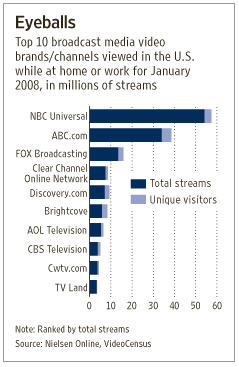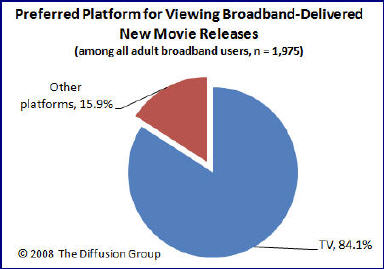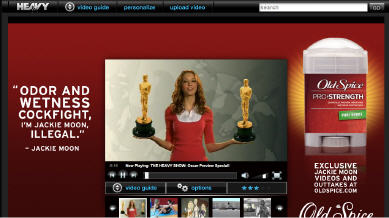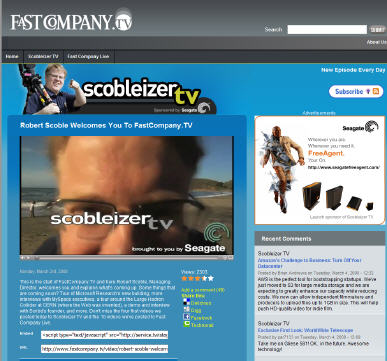-
Hurray for TiVo-YouTube
Hurray for TiVo and YouTube, which yesterday announced a partnership to allow certain TiVo users to watch YouTube videos on their TVs. While the actual number of homes which have the right TiVo model
 and have it connected to broadband numbers under a million, TiVo-YouTube shows there is still hope that the worlds of broadband video and TV will indeed converge.
and have it connected to broadband numbers under a million, TiVo-YouTube shows there is still hope that the worlds of broadband video and TV will indeed converge.Some of you will remember that in December '07 I wrote a post entitled "Broadband Video on TV is a Mirage" in which regrettably concluded that the mass availability of broadband video on TVs was nowhere on the horizon. In that post I wrote:
"The minority of consumers who will actually see broadband video on their TVs will either (1) shell out big bucks to buy a broadband appliance such as Vudu or Apple TV, (2) tackle the challenge of connecting their TVs via wireless networks (3) use a device built for another primary purpose, such as Xbox 360 or TiVo, to selectively augment their viewing with broadband-delivered choices or (4) use a service provider that has decided to throw in a few morsels of broadband video."
With the YouTube deal, TiVo continues to deliver on option 3, augmenting an already impressive array of broadband video available on select TiVo models. TiVo enhances its overall reputation for innovation
 (although still absent resounding market success or profitability), with a particular focus on broadband video. TiVo has previously offered up Amazon Unbox, TiVoCast, Music Choice, Home Movies, etc. Providing access to YouTube, the world's most popular video site, is another notable accomplishment for TiVo.
(although still absent resounding market success or profitability), with a particular focus on broadband video. TiVo has previously offered up Amazon Unbox, TiVoCast, Music Choice, Home Movies, etc. Providing access to YouTube, the world's most popular video site, is another notable accomplishment for TiVo.I continue to believe that whichever company cracks the code on how to deliver wide open broadband video access to the TV - coupled with a strong user experience - is going to hit it big. At the risk of looking too far backward, at the end of 2006 I conjectured that Apple's then still-to-be-launched Apple TV product could be a resounding success if it got the content strategy right (i.e. offering open broadband access and even focusing particularly on easy YouTube access through the device). Instead Apple TV has turned into yet another walled garden and to date has been a market failure. Apple continues to miss the open broadband market opportunity which is sitting right in front of it with a big bulls-eye plainly visible.
The TiVo-YouTube partnership will hopefully have the effect of accelerating the wake up call to other market participants that this gigantic opportunity awaits. Broadband video to the TV is a natural. It simply extends the cable/satellite model of the last 30 years: offering ever more video choices right to the TV.
As I've often said, as amazing as the growth curve has been for broadband video consumption over the last 5 years, even more amazing is that virtually all of this consumption has happened on the computer - a completely parallel world to the traditional TV viewing platform. Nobody could have imagined this level of consumer adoption for a non-TV viewing platform. So then look forward and imagine the possibilities when broadband video and the TV are fused for the masses.
Categories: Devices, Partnerships
Topics: Apple, Apple TV, TiVo, YouTube
-
Welcome to the "Syndicated Video Economy"
I am ever mindful of the old adage about "missing the forest for the trees" as I try daily to understand the often minor feature differences between competing vendors or the nuances of startups' market positioning. As we all know, when you get too close to something, it's quite easy to lose the larger perspective. So periodically I think it's essential to take a huge step back to try to identify the larger patterns or trends that crystallize from the daily frenzy of deals and announcements.
As a result, I've come to believe that recent industry activity points to an emerging and significant trend: the early formation of what I would term the "syndicated video economy." By this I mean to suggest that I'm
 seeing more and more industry participants' strategies - in both media and technology - start from the proposition that the broadband video industry will only succeed if video assets are widely dispersed and revenue creatively apportioned.
seeing more and more industry participants' strategies - in both media and technology - start from the proposition that the broadband video industry will only succeed if video assets are widely dispersed and revenue creatively apportioned. For content providers the notion of widespread video syndication big change in their business approach. In the past year I think we've observed content providers of all stripes transition from "aggregating eyeballs", to "accessing eyeballs," wherever they may live now or in the future: portals, social networks, portable devices, game consoles, etc. Underlying this shift is the realization that advertising-based revenues are going to fuel the broadband video industry for the foreseeable future. The ad model requires scale and syndication is the best way to deliver it.
This shift by content providers has been accompanied by a loosening of traditional tightly-controlled, scarcity-driven distribution strategies, an acknowledgement that fighting newly-empowered consumers is a futile exercise. The evidence of this shift abounds. Consider the broadcasters like CBS, NBC and Fox, which through their affiliates (Hulu, CBS Audience Network) are syndicating programming to many portals/aggregators (e.g. Yahoo, MSN, AOL, YouTube), social networks (e.g. Facebook, MySpace, Bebo) and others. And Disney's Stage 9 digital studio, which premiered with YouTube and explicitly plans to tap into broadband video hubs. And cable networks like MTV Networks, which is pursuing a plethora of distribution deals. And traditional news-gatherers like local TV stations, newspapers and news services (e.g. Reuters, AP) which have stepped up their activity to scatter their video clips to the Internet's nooks and crannies. And the list goes on and on.
Taking their cue from the media companies' strategy shift, technology entrepreneurs and investors have ramped up their focus on this market opportunity. The prospect of the syndicated video economy blossoming drives news/information distributors such as Voxant, ClipSyndicate, Mochilla, TheNewsMarket and RedLasso, an ad manager such as FreeWheel, and a content accelerator such as Signiant, plus many others. Then there are more established companies guiding areas of their product development process by the prospect of the syndicated video economy's growth: Google, WorldNow, Akamai, thePlatform, Anystream, Maven Networks, Brightcove, PermissionTV and plenty of others (apologies to those I've left out!)
All of this suggests that the eventual "value chain" of the broadband video industry will look quite different than the traditional one (for more on this, I've posted some my slides from late '07 here.) As with all economies, in the nascent syndicated video economy there is vast interdependence among the various players, not to mention shifting market positions and degrees of pricing power and negotiating leverage. It is far too early to gauge who will emerge as the syndicated video economy's winners and losers. But make no mistake, lots of energy and investment will be expended trying to nurture its growth and exploit its opportunities.
Do you see the syndicated video economy forming as well? Post a comment and let us all know!
Categories: Advertising, Aggregators, Broadcasters, Cable Networks, Newspapers, Portals, Startups, Syndicated Video Economy
Topics: Akamai, Anystream, ClipSyndicate, FreeWheel, Google, Mochilla, RedLasso, Signiant, TheNewsMarket, thePlatform, Voxant, WorldNow
-
CBS TV Stations Get Broadband Under Leess
(Note: This is the third in a series of posts with companies participating in the 2008 Media Summit, a premier industry event starting tomorrow in NYC. VideoNuze has partnered with Digital Hollywood, the Media Summit's producer, to provide select analysis and news coverage.)
A few months ago, in a post I wrote called "Broadcast TV Stations Most Threatened By Broadband/On-Demand," I asserted that broadband was bringing a perfect storm to the world of local TV stations.
These thoughts were in the background when I spoke last week with Jonathan Leess, President and GM of CBS TV Stations Digital Media Group. CBS owns 29 stations around the U.S. mostly in bigger markets. Leess has been in his role since April '04 and by all accounts has done an admirable job leading the CBS stations into the broadband era.

Most significant is the delicate balance he's tried to strike in centralizing certain online/broadband responsibilities while keeping others at the local level. This is no easy feat. Succeeding online requires scale and common technology platforms. Yet historically local stations enjoy wide autonomy in decision-making as long as they meet their numbers.
Leess explained that in broadband he's focused his corporate group on accessing and providing new non-local content, creating an internal syndication network for stations, developing technology and tools for all stations to use, focusing on national ad sales and training for local sales reps, and importantly generating new viewership by syndicating local stations' video to third parties.
A key part of executing the balancing act has been a relentless focus on work-flow and supporting technologies. Leess explained that the broadband activities at CBS TV Stations are a 24/7 operation involving hundreds of people around the country. Turning all of this into a well-oiled operation, particularly in the context of long-standing operational biases, has been an enormous operational challenge that Leess seems to have embraced.
His efforts seem to be paying off. CBS TV Stations drove 89 million video views from their own sites in '07, an average of around 8 million video views/mo from their own sites, a 71% increase over '06. It's gaining an additional 10 million video views/mo through syndication partners. The primary current contributor to
 syndication is Yahoo, with whom CBS TV Stations partnered in Oct '06. To put this in context, today's WSJ carried the adjacent graphic of select broadcasters' video views. Putting aside CBS TV Stations' 10 million monthly syndication streams, its '07 monthly average traffic would appear to rank it in the top 5, right around Discovery.com.
syndication is Yahoo, with whom CBS TV Stations partnered in Oct '06. To put this in context, today's WSJ carried the adjacent graphic of select broadcasters' video views. Putting aside CBS TV Stations' 10 million monthly syndication streams, its '07 monthly average traffic would appear to rank it in the top 5, right around Discovery.com. In addition, video clips are a big part of CBS TV Stations' success, as it is posting around 520/day and now offers a searchable library of 350K clips.
Meanwhile the Yahoo deal has been so successful that CBS TV Stations has clearly gotten syndication religion, with several significant announcements planned for the coming weeks. Leess explained how these syndication deals drive unprecedented consumption from out-of-market viewers while also creating valuable ad inventory. For pre-rolls, CBS is getting between $28-75 CPM, with banners fetching $8-18 CPM. Importantly, CBS TV Stations are aggressively bundling on-air/online/broadband packages, having sworn off broadband as a pure "value-add" some time ago.
While I stand by my assertion that local TV stations are most vulnerable to broadband's rise, it is also true that broadband offers stations fresh opportunities. CBS TV Stations' offensive approach shows that with the right leadership, strategy and operational plan, executing a successful transition to the broadband era is quite possible.
What do you think? Post a comment and let everyone know!
Categories: Broadcasters, Portals
Topics: CBS, CBS TV Stations Digital Media Group, Yahoo
-
Fueling Over-the-Top Broadband Video
Today I'm very pleased to introduce Michael Greeson as a contributor to VideoNuze. Michael is the founding partner and Principal Analyst at The Diffusion Group, a leading analytics and advisory firm helping
 companies in the connected home and broadband media markets. VideoNuze has partnered with TDG to bring key highlights of its research and opinions to VideoNuze readers on a regular basis. I'm confident that you'll find them valuable and, as always, look forward to your feedback.A Simple Way to Fuel Diffusion of Over-the-Top Broadband Videoby Michael Greeson
companies in the connected home and broadband media markets. VideoNuze has partnered with TDG to bring key highlights of its research and opinions to VideoNuze readers on a regular basis. I'm confident that you'll find them valuable and, as always, look forward to your feedback.A Simple Way to Fuel Diffusion of Over-the-Top Broadband Videoby Michael GreesonWith the web becoming more about media and entertainment, the rationale to get a broadband conduit into the living room is irrefutable - after all, that's where most consumers have their high-definition TV and their best sound system, it's the home's most comfortable media setting and remains the preferred platform for watching video. Not that a laptop PC in the den, a second TV and stereo in the master bedroom, or even an iPhone are not interesting as video consumption points; of course they are, but not as the primary or preferred setting. As noted below, when asked to choose between TVs, desktop PCs, notebook PCs, or mobile video platforms, close to nine in ten consumers prefer to watch movies on their living room TV.
 Then why are those companies which are pushing a "three screen" video consumption strategy spending most of their energy and resources on the two "new" spaces (that is, PC-based or portable/mobile video consumption) and forgetting about the living room TV altogether? It seems as if open broadband to the TV is not sexy or cool enough for Silicon Valley; too mundane for such "cutting edge" companies.
Then why are those companies which are pushing a "three screen" video consumption strategy spending most of their energy and resources on the two "new" spaces (that is, PC-based or portable/mobile video consumption) and forgetting about the living room TV altogether? It seems as if open broadband to the TV is not sexy or cool enough for Silicon Valley; too mundane for such "cutting edge" companies.I've got news for them: watching video on the TV is not going away anytime soon, meaning that emerging new video models (the other two screens) will serve as supplements to the living room TV, not as replacements. Those pointing to TV's demise (a dubitable and specious position to hold) must know that, even if this happens, it will come about very, very slowly. The TV has proven an incredibly resilient and flexible viewing platform, one whose primacy will be reinforced by new media, not compromised.
For these reasons, I advocate a very simple strategy to help push broadband connectivity into the living room and broadband video into its rightful place. Forget about earmarking Internet connectivity as a "premium" feature reserved only for high-end CE, game consoles, or novel "new media" platforms like Apple TV. Think beyond adding Internet connectivity to a TV (which has a replacement cycle of six to eight years) or a high-def DVD player (a higher-end platform seen as unnecessary to most consumers).
Instead, add Internet connectivity to mainstream consumer electronic devices that are widely diffused, dependable, and which enjoy a more rapid replacement cycle - devices such as low-to-mid-range DVD players. Yes, it would increase the cost of the DVD player, but only slightly, and if there is legitimate value in delivering web-based media to the living room, the cost increase will be seen as tolerable. In the end, there is no better way to accomplish widespread, rapid diffusion than to tie a compelling new application to a trusted (existing) platform that's several hundred dollars cheaper than similarly-enabled platforms.
The argument I've presented above is relatively commonsensical: it is inherently easier to enhance incrementally the features and capabilities of a stable, widely diffused, well-loved platform (like a DVD player) than to try to sell consumers a completely new "black box" that enables a specific set of benefits that, while convincing, may not by themselves be sufficiently compelling to generate a purchase. Moreover, "new media" can benefit immensely by serving "traditional environments." While it is interesting to envision a future where anytime/anywhere video consumption is possible, at this point simply enhancing the primary video experience may be the most practical for "three screen" broadband video players. While not as "hot" or "cool," it will likely prove the most lucrative.
Categories: Aggregators, Devices
Topics: The Diffusion Group
-
UGC and Brand Marketing, Part 2
Wrapping up the week, today I revisit a post from several weeks ago, "An Intersection of UGC and Brand Marketing?"
In that post I mused about the opportunity for brand marketers to harness the recent enthusiasm many consumers have for creating video, as evidenced by the popularity of sites like YouTube. The idea I floated concerned how brands might somehow incent consumers to produce informative videos about their favorite products, which in turn could be showcased by the brands to help prospective buyers were in research mode. It seemed to me there might be a happy marriage in there somewhere.
It turns out I may have had my head in the clouds on this one. Daphne Kwon, CEO of ExpoTV reached out to me to explain some of the realities that my idea would encounter. Daphne's in a good position to know, since ExpoTV runs a site offering users the opportunity to upload videos with their reviews/opinions about products. ExpoTV has aggregated over 200K of these "Videopinions" to date. ExpoTV isn't exactly the concept I had in mind to marry UGC and brands, but it's definitely in the same ballpark.

Daphne raised two issues which she believes constrains brands from pursuing the user-generated reviews idea I envision. First is the specter that these reviews will be biased in some way. There are multiple dimensions to this. Will the brand maintain a completely open environment so that even negative reviews would be posted? If so, what are the implications? If not, and only positive videos are exposed, then the area wouldn't feel authentic or trustworthy. Also, would reviewers bias toward saying positive things simply to ingratiate themselves with the brand for ulterior reasons, such as getting noticed to be in a future ad or obtain funding for a private project?
Further complicating this is Daphne's sense that when people upload videos they're doing so to be part of a community that is responsive and interactive. This has clearly been a big part of YouTube's success. So brands couldn't just offer a place to upload, but rather would need to hire staff to manage the area, interact with participants, figure out how the area should be policed or self-policed, etc. Daphne doesn't see brands biting all off all of this, as it's a lot of work and she doesn't see any corporate mandates for brands to actively participate in these kinds of community-building activities.
Second and possibly more problematic is that there may be legal liability for brands to provide such platform, as the brands might be held responsible for the truthfulness and accuracy of the user-submitted videos. This liability would be broad, ranging from the relatively small (e.g. "The product didn't work as explained") to the very significant (e.g. "I used the product this way and was injured."). Clearly, in the litigious society in which we live, deep-pocketed corporations could be exposing themselves to all kinds of financial risks. Then of course there is the risk of negative PR, which alone could be quite damaging. Tying back to issues above, if there isn't a clear mandate to pursue these activities, no astute corporate soldier is going to risk his/her career diving into such precarious waters.
Hearing these considerations makes me think that the optimal route for incenting user-created video reviews may just be the way ExpoTV is doing it. Provide a "well-lit" space with a mix of financial incentives and community recognition, and monetize traffic in a number of creative ways (affiliate deals, advertising, etc.). Importantly maintain a focus on the community-building tasks required for motivating active and continuous user participation.
All of this serves as another reminder that with broadband - as with technology in general - just because something is possible, doesn't necessarily make it advisable.
What do you think? Post a comment and let us all know!
Categories: Brand Marketing, UGC
Topics: ExpoTV
-
Heavy Plans Big Push for Husky Ad Platform
(Note: This is the second in a series of posts with companies participating in the 2008 Media Summit, a premier industry event which will be held next week in NYC. VideoNuze has partnered with Digital Hollywood, the Media Summit's organizer, to provide select analysis and news coverage.)
Heavy Corporation, which operates Heavy.com, one of the most popular independent broadband video destinations for 18-34 males, is poised to make a push into the ad platform/network business through its
 Husky Media unit. I spoke to Eric Hadley, Heavy's chief marketing officer yesterday who filled me in on their plans.
Husky Media unit. I spoke to Eric Hadley, Heavy's chief marketing officer yesterday who filled me in on their plans.The Husky platform is currently used today by Heavy.com. If you go to the site, you'll see how it operates, showing just one ad with the video selected. As Eric explains, the video is wrapped in the advertiser's skin, so upon starting the video player exposes a big interstitial ad for 2 1/2 second that sort of feels like "barn doors" before opening to the video itself. Then when the video plays, display ads surround the content. Additional related content is queued up and automatically starts playing subsequently. This approach has resulted in a 270% lift in videos viewed as compared with the pre-queuing implementation. This of course means more video usage and more advertising exposure.
 Eric believes that this video presentation/ad format is unique in the industry (I agree, I haven't seen anything else like it), and goes straight to the biggest question in the industry: how are people actually going to make money from their broadband video content, especially original creations. Husky aims to combine the best of pre/mid-roll ads with the best of display.
Eric believes that this video presentation/ad format is unique in the industry (I agree, I haven't seen anything else like it), and goes straight to the biggest question in the industry: how are people actually going to make money from their broadband video content, especially original creations. Husky aims to combine the best of pre/mid-roll ads with the best of display.Eric said that advertiser enthusiasm for the Husky presentation has prompted Heavy to now offer it to other publishers who target demos other than Heavy.com's 18-34 males. It's still early days, but Eric said that in the next few weeks several major publishers will be launching Husky implementations, as will small-to-medium sized sites. This will form the beginnings of an ad network Heavy can assemble and offer to advertisers. By evolving Husky's focus from internal-only use to external use as well, Heavy will be competing with broadband ad players such as Tremor, Broadband Enterprises and others. The Husky move shows how dynamic the broadband video ad space is, with multiple kinds of formats and implementations being tested and used by content providers seeking to maximize monetization.
Meanwhile Heavy is continuing to build out its Heavy.com destination site, which currently receives 17M+ visitors/mo. Key upcoming focuses are music/urban, cars and racing, sports and travel categories. These are all the purview of the Heavy's recently added head of programming, Jimmy Jellinek, former editor at Maxim. Content sourcing is varied, with Heavy.com producing some of its own, producing some for its advertisers and also some it obtaining some from others, such as Transworld. In the U.S. today, Heavy does not syndicate its programming to others sites, which is a somewhat contrarian position vs. other content providers who are syndicating widely.
Looking ahead to the Media Summit, Eric plans to explain more about the upcoming Husky push and how content providers and advertisers can benefit from it. He also sees the Media Summit as an ideal forum to learn from others what's making a difference in the industry and what's hot.
Categories: Advertising, Indie Video, Technology
Topics: Heavy, Husky Media
-
TidalTV: Another Well-Funded Aggregator Goes For It
(Note: This is the first of a series of posts with companies participating in the 2008 Media Summit, a premier industry event which will be held next week in NYC. VideoNuze has partnered with Digital Hollywood, the Media Summit's producer, to provide select news and analysis coverage.)
Investors continue to show lots of optimism about the broadband video aggregator category. The latest data point is TidalTV, a new entrant that announced last week it has raised $15 million from NEA and Valhalla Partners. This comes on top of a crowd of well-funded startups: Joost ($45M+), Veoh ($40M+ to date), Building B ($17.5M), Vuze ($32M+), Hulu ($100M) and many others who are attacking this space in one way or another.
To better understand how TidalTV will distinguish itself from the pack, yesterday I had a lengthy briefing with CEO Mollie Spilman. She provided her first extensive remarks about TidalTV's game plan since last week's announcement. (Thanks to my old friend Tom MacIsaac, former CEO of Lightningcast, for facilitating the introduction. Tom recently launched Cove Street Partners and is as smart a player in the broadband video ad space as anyone around.)
The first thing to know about TidalTV is that it is pursuing mainstream users, not early adopters. This targeting pervades all its decision-making: site design is clean and approachable (Mollie said Apple is their role model), content is professional/well-branded only (no UGC), user experience incorporates a traditional linear programming sensibility combined with full on-demand access and advertising mimics traditional pods, while also integrating new broadband-only formats.

In short, TidalTV's making a bet that given how nascent broadband video adoption is among mainstream users, there is ample room to become the brand/destination of choice by providing an experience that feels more similar to traditional TV than to online. Though Mollie says that Apple is TidalTV's heaviest influence, I see clear parallels to AOL from the mid-late '90s. Recall that AOL's pervasive consumer-friendly UI, content and marketing (the Steve Case mantra) enabled it to crush all the dial-up ISPs which had more techie, complicated orientations. Watching AOL's rise made me a big believer that consumer-friendliness can indeed be a meaningful competitive differentiator if executed really well.
AOL is an interesting point of comparison because TidalTV's founder Scott Ferber was a co-founder of Advertising.com, which was sold to AOL in 2004, albeit after the Case era ended at AOL. Mollie was at Ad.com for 6 years as well. Other TidalTV executives come from Ad.com, Joost and Fox. The Ad.com lineage helps explain why TidalTV has chosen to invest significantly in optimizing its advertising capabilities rather than building a lot of its own publishing or delivery features (note TidalTV is all Flash-based streaming with no downloads and no P2P).
TidalTV has some interesting challenges ahead. First is content. It sounds like the company has made substantial progress in deals to obtain content from the "top 50 brands" which includes not only broadcast and cable network fare, but also print, online publishers and others who produce professional video. Yet Mollie concedes that "90% of TidalTV's content at launch could probably be found somewhere on-air or online," as content providers increasingly pursue widespread syndication. TidalTV's opportunity is to pull the content together in a neat, intuitive manner that mainstream users appreciate.
TidalTV will do so by using a "faux linear" presentation, which entails it becoming a "digital programmer," assembling its partners' shows into their own channelized formats (e.g. "The CSI Channel"), with traditional linear air times. For example, if you come to the site at 4pm, you'd see "what's on now" on multiple channels. At launch Mollie anticipates offering 10-15 channels, all on a revenue share basis with providers. This presentation approach is meant to appeal to mainstream users by providing a tangible link to a TV-oriented experience. If a user clicks to start watching, a linear "feed" will start playing, including ad breaks. However, TidalTV will also offer all programs on a full, on-demand basis as well.
But to illustrate how complicated the content acquisition terrain is for 3rd parties like TidalTV, consider Hulu, the NBC/FOX JV. It has insisted that prospective syndication partners take the Hulu player if they're to gain access to popular shows like "Heroes" and "24." Doing so could break TidalTV's user-friendly design. Mollie acknowledged this challenge, but felt confident that in examples like these, there should be adequate incentives to work out an arrangement. Then there's ABC, which to date has not pursued syndication aggressively. If it maintains its ABC.com centric approach, simply not making its programs available to 3rd parties, that leaves aggregators with obvious holes in their offerings. This would be especially challenging for a site like TidalTV, which appeals directly to mainstream users. Speaking generically, Mollie said that TidalTV's neutral "Switzerland" approach (i.e. no investments from media companies) should help in all of its content negotiations.
Driving traffic is another key issue. With other players in the market already, they've had a chance to build their traffic, though not necessarily in TidalTV's core target audience. For instance, Veoh alone says it's getting 20M+ unique visitors per month. To jumpstart traffic, Mollie said that TidalTV is prepared to fund an aggressive marketing plan, testing direct marketing, search, offline ads, outdoor, SEO, viral, PR and other tactics.
TidalTV expects to offer a geo-based limited beta in the Maryland, Virginia and DC area in late March, expanding to a national beta in mid-April. I'll be getting a peek at the beta product next week, so I'll have more to say then. Though it's still far too early to make a definitive assessment of TidalTV's chances of success, I like the fact that Mollie repeatedly uses the word "experimental" in her comments. That's a recognition of how early-stage this market space is and suggests TidalTV will stay flexible and open to all approaches to find success.
What do you think of TidalTV's chances? Post a comment and let everyone know!
Categories: Aggregators, Startups
Topics: ABC, AOL, Building B, FOX, Joost, NBC, New Enterprise Associates, TidalTV, Valhalla Partners, Veoh
-
FastCompany.TV Launches, Scoble at Helm
Yesterday Fast Company magazine officially launched its previously announced FastCompany.TV initiative as "a new kind of business video network." It is another indicator of how broadband is raising the competitive bar in the today's video business.

FC hired Robert Scoble, who ran Scobleizer, an extremely popular technology blog, to be the venture's managing editor. The first programs announced yesterday were "Scobleizer TV," mainly interviews with technology and innovation leaders shot in HD, and "Fast Company Live," which is being shot with a cell phone (yes, a cell phone) and presented in a rough-and-raw, "you're in the front row" experimental style.
FC.TV's launch follows many other magazines' forays into broadband video. I've often said, including in last week's webinar, that print publishers (newspapers and magazines) could well become the most formidable new source of video programming in the coming broadband era. About a year ago, I synthesized some of these thoughts in a report entitled "The Top 40 U.S. Magazines: Learning to Thrive in a Multi-Platform World," in which I asserted that "broadband video offered magazines a once-in-a-generation strategic growth opportunity to leverage their incumbent audiences, trusted brands, editorial expertise and advertising relationships in this new medium." I spoke to Robert yesterday and he concurred with this assessment, offering that "magazines do well in a niche world by understanding targeted audiences, how to serve them and make money at it." He has some previous experience at a 100K circulation title which used a combination of subscriptions, advertising and events to build a very healthy business. Robert believes these kinds of capabilities will serve magazines well in the broadband age.
I spoke to Robert yesterday and he concurred with this assessment, offering that "magazines do well in a niche world by understanding targeted audiences, how to serve them and make money at it." He has some previous experience at a 100K circulation title which used a combination of subscriptions, advertising and events to build a very healthy business. Robert believes these kinds of capabilities will serve magazines well in the broadband age.I asked Robert if he had considered aligning his brand to a broadcast or cable network instead of Fast Company. Though he said he had some conversations, he quickly realized that their approaches were not congruent with his. He saw that traditional networks produce very expensively, with multiple cameras, lights, sets, makeup, etc, all of which creates the lavish look we see on TV. Robert points out that all of this means networks spend a lot of money and time to create just a relatively small amount of actual video (he offered one example he knew of where it took 10 hours to create 2 minutes of video). All of this creates a culture in which executives have a hard time relating to his innovative, low overhead approach.
Conversely, he believes that broadband video must be shot economically, efficiently and creatively, with an eye toward maximizing the ratio of video shot to video aired. As he put it, in a "Google-powered trillion channel world, where each channel may only have 50 or 500 or 5,000 viewers, building media at a low-enough cost enables you to do very well. And the Internet offers the chance to present video that never would have been made in the traditional world."
These sentiments perfectly capture what I see as broadband video's ultimate impact: providing a different consumer experience unencumbered by traditional yardsticks and technologies, with the results being a proliferation of consumer choices and real competition to incumbent players.
Another interesting aspect of FC.TV is that it uses Twistage, a relatively new video publishing and management platform. I had spoken to their CEO David Wadler a couple of weeks ago, and he explained that Twistage is a highly flexible, API-rich platform that he believes is much cheaper than competitors. Robert said he likes Twistage's turnkey ASP approach, which allows FC.TV to outsource just about everything, eliminating a lot of what he called the "drudge work." Wadler told me there are other media customers to be announced soon, so Twistage looks to be an emerging player in this already quite crowded space.
Taken together, FastCompany.TV shows how aggressive magazines can use broadband video to significantly expand the scope of the businesses.
What do you think? Post a comment and let everyone know!
Categories: Magazines
Topics: Fast Company, FastCompany.tv, Robert Scoble, Twistage


